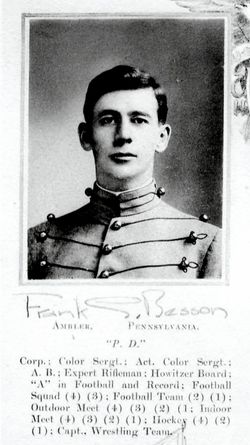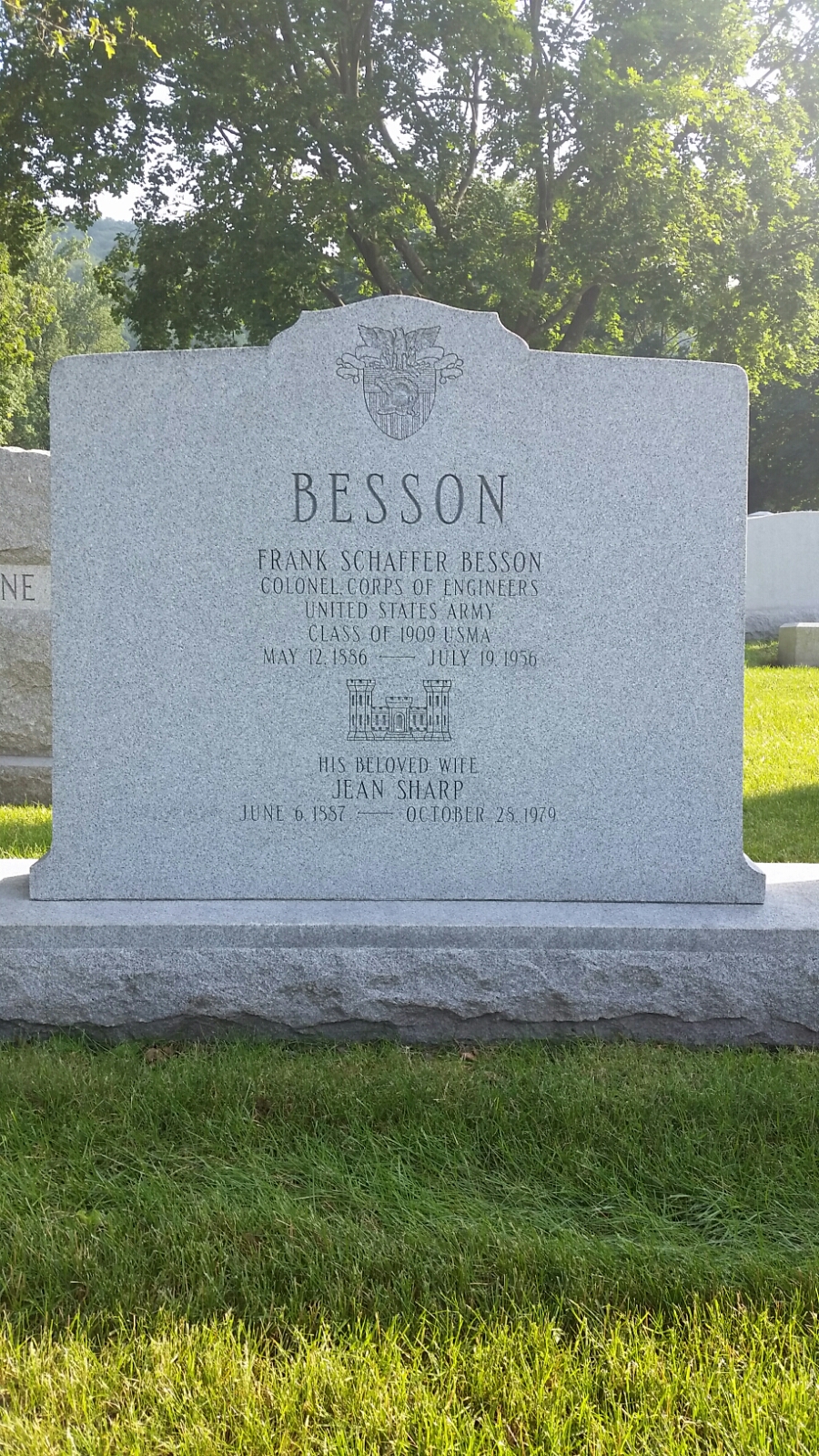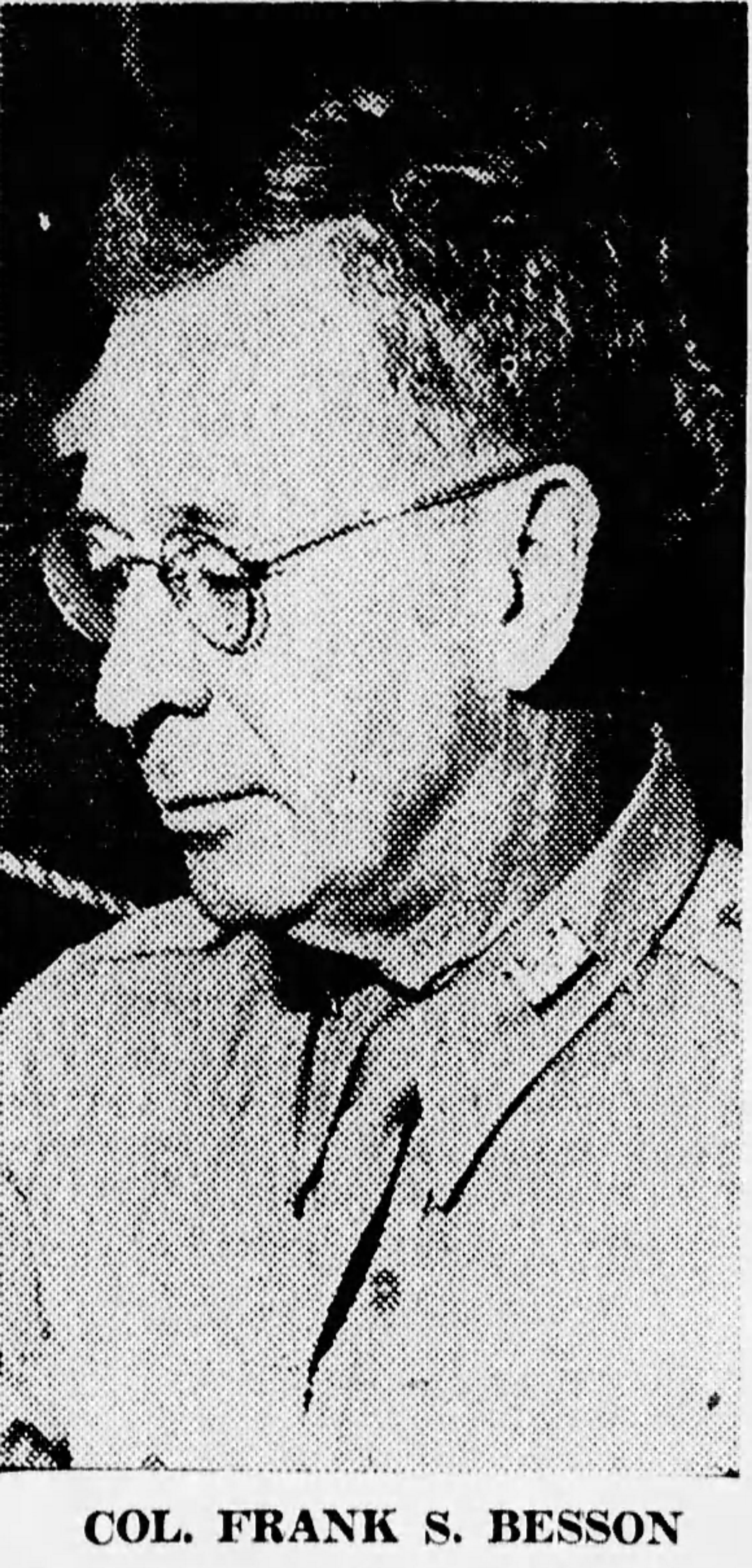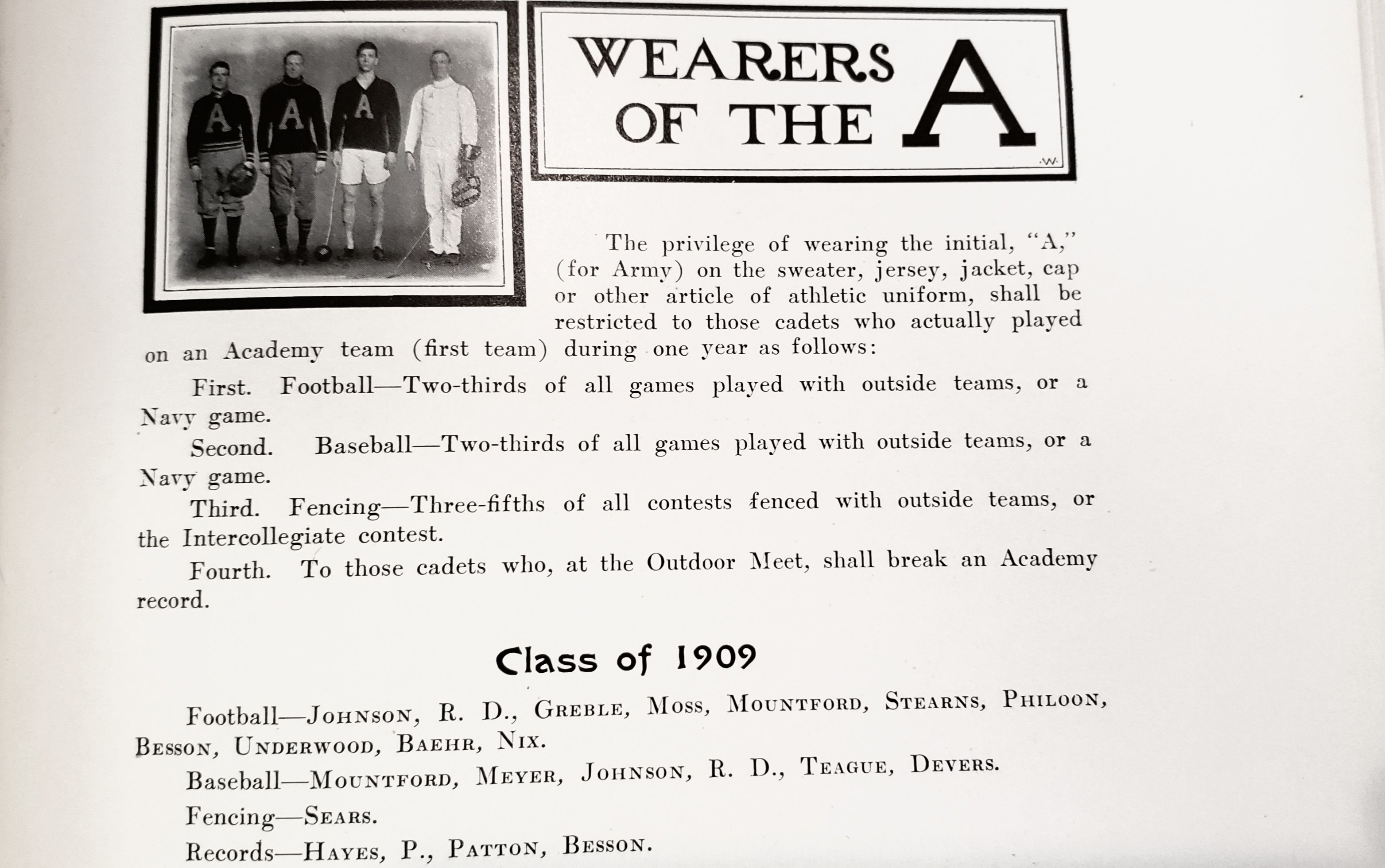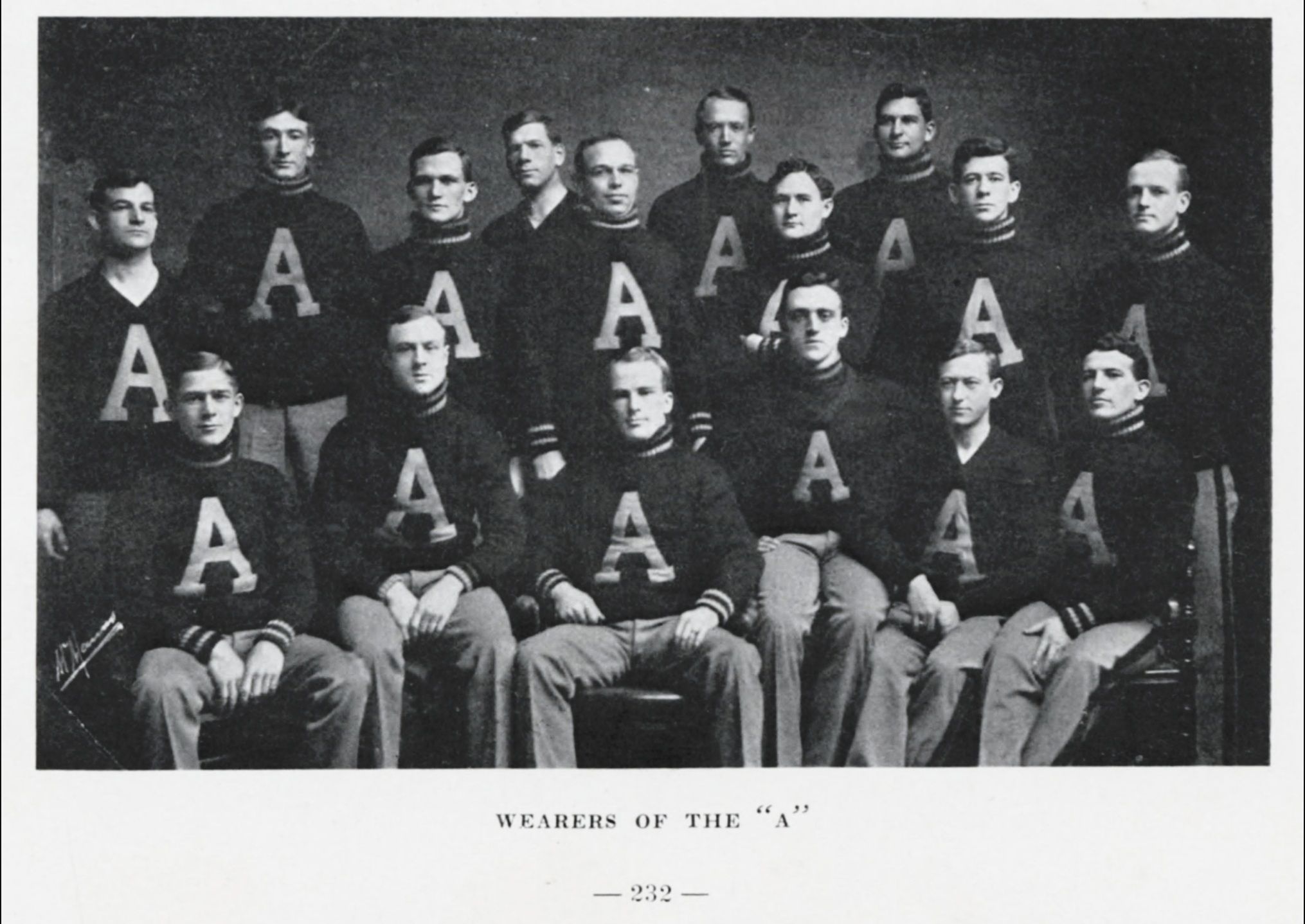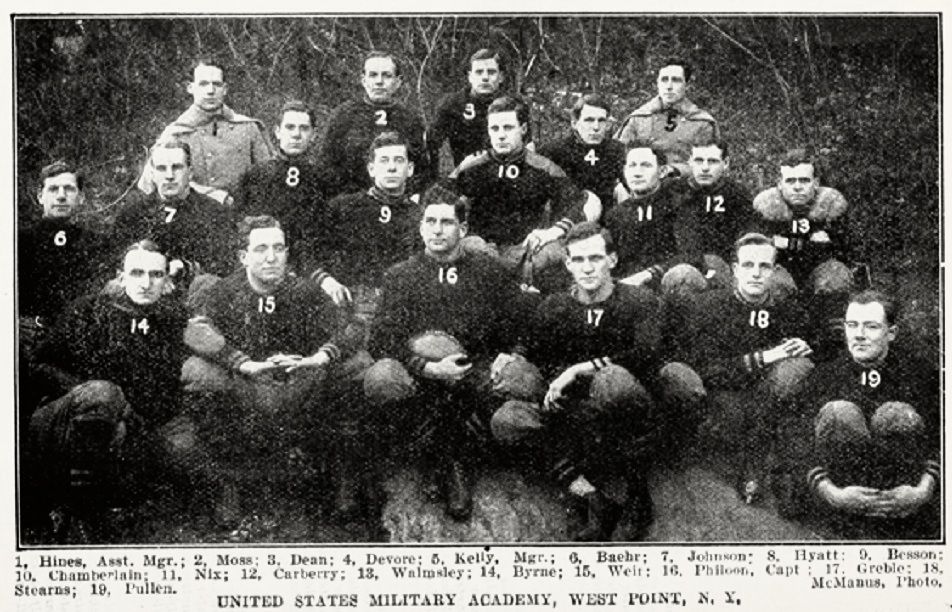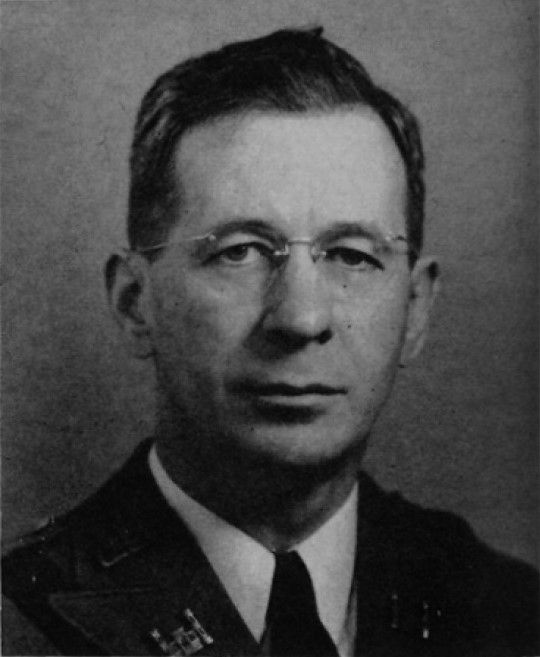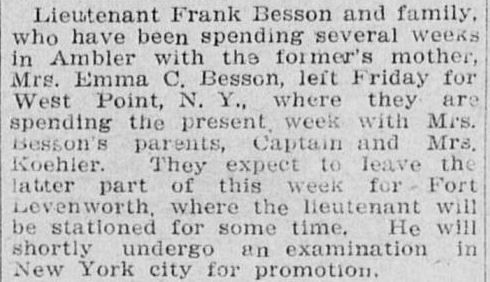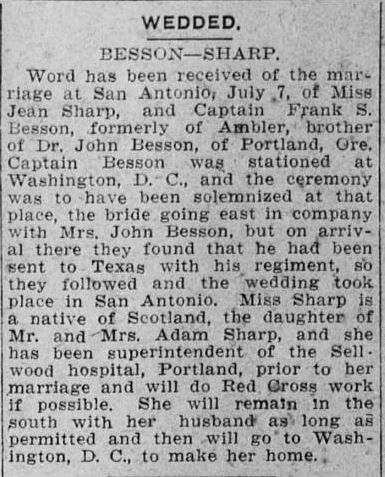He was the son of Linford S. Besson and Emma Grose Besson.
On July 19, 1909 as Frank Schaffer Besson, he married Virginia Patricia Koehler at the home of the bride's father at West Point, New York.
She was the daughter of Captain Herman J. Koehler.
They were the parents of two children.
On July 7, 1916 as Frank S. Besson, he married L. Jean Sharp at San Antonio, Texas.
They were the parents of one child.
Frank Besson was born on May 12, 1886 in Philadelphia, Pennsylvania on May 12, 1886. He moved with his family to Ambler, Pennsylvania, where his father opened a general mercantile business. After graduating from high school, he spent a year at William Penn Charter School in Philadelphia. He was the first member of his class to report to West Point in June 1905. On June 11, 1909, he graduated from the Military Academy, number 13 in a class of 103. He received the sabre awarded to the outstanding member of each class in general athletic ability and participation. He was commissioned as a Second Lieutenant of the Corps of Engineers and spent his entire commissioned service, serving in all grades to include Colonel. While on graduation leave he married Virginia Koehler. The next year was spent in study and observation of the works of the Corps of Engineers on the Mississippi and Illinois Rivers, the Panama Canal, the Great Lakes, and the Ohio River and United States tributaries. The following year was spent at the Engineer School of the Army. While at Detroit, Michigan on Great Lakes duty, his son Frank, Jr., the class cup boy, was born. Subsequently, while a student at the Engineer School, a second son Robert was born. Upon graduation from the Engineer School he served for a few months with Engineer troops at Fort Leavenworth, followed by four years in Hawaii, with troops and as an assistant to the Department Engineer. While on duty with the Engineer battalion, he organized and coached a company football team which won the championship of the Islands. In 1915, he returned from Hawaii and did company and staff duty with the 1st Engineers at Washington Barracks, Forts Sam Houston and Brown, Texas, and later returned to the Washington Barracks. In 1916 he obtained a divorce from his first wife and later the same year he married Jean Sharp. They were the parents of one daughter, Jean. In August 1917, as Adjutant of the 1st Engineers, he accompanied the regiment to France. He saw combat service in the Toul, Cantigny and Soissons sectors with his regiment of the First Division and reached the temporary grade of Colonel. In August 1918, he returned to the United States, becoming Camp Executive of Camp Humphries, Virginia (now known as Fort Belvoir), which is the principal training center of the Corps of Engineers. He served there until January 1919, when he was appointed Assistant Engineer Commissioner of the District of Columbia until July 1923. During this time he wrote, City Pavements. He attended the Command and General Staff School, where he was Distinguished Graduate of the class of 1924. He remained as an instructor at the school for four years. He published a pamphlet Elements of Tactics, which served as a guide to students at the Command and General Staff School and other service schools. From 1928-1929, he was a student at the Army War College. He then served four years as District Engineer of the Nashville, Tennessee District; four years in the Office, Chief of Engineers, Washington; three and a half years as District Engineer, Galveston, Texas District, and 16 months as Division Engineer of the Missouri River Division with headquarters at Kansas City, Missouri. During World War II, he was in Command of the 8th Engineer Training Group and the Engineer Replacement Training Center at Fort Leonard Wood, Missouri from April 1942 to January 1943. From February to December 1943 he organized and then commanded the Engineer Replacement Training Center at Camp Abbot, Oregon. His final duty was at Fort Lewis, Washington, where he commanded the Engineer Training Section of the Army Service Forces Training Center. In September 1945, he was retired for physical disability. His Decorations and Awards for his active service included Commendation Ribbon with Metal Pendant; World War I Victory Medal with three Battle Clasps for Montdidier-Noyon, Aisne-Marne and Defensive Sector; Mexican Border Service Medal; American Defense Service Medal; American Campaign Medal and World War II Victory Medal. He and his wife, Jeanie settled in Portland, Oregon and he was later diagnosed with cancer. His first operation was performed in May 1946 and he underwent numerous operations for the condition before his death. He died on July 19, 1956 in Portland, Oregon. He had requested to be buried at West Point. Survivors included his wife Jean; his son Frank, USMA Class of 1932; his son Robert, USMA Class of 1937; his daughter Jean, married to Colonel Milton B. Adams, USMA Class of 1939, United States Air Force; 11 grandchildren and his brother, Dr. John Besson of Portland, Oregon. In 1970, Jean Besson married Max C. Tyler, USMA Class of 1903.
Source: United States Military Academy Association of Graduates memorial.
He was the son of Linford S. Besson and Emma Grose Besson.
On July 19, 1909 as Frank Schaffer Besson, he married Virginia Patricia Koehler at the home of the bride's father at West Point, New York.
She was the daughter of Captain Herman J. Koehler.
They were the parents of two children.
On July 7, 1916 as Frank S. Besson, he married L. Jean Sharp at San Antonio, Texas.
They were the parents of one child.
Frank Besson was born on May 12, 1886 in Philadelphia, Pennsylvania on May 12, 1886. He moved with his family to Ambler, Pennsylvania, where his father opened a general mercantile business. After graduating from high school, he spent a year at William Penn Charter School in Philadelphia. He was the first member of his class to report to West Point in June 1905. On June 11, 1909, he graduated from the Military Academy, number 13 in a class of 103. He received the sabre awarded to the outstanding member of each class in general athletic ability and participation. He was commissioned as a Second Lieutenant of the Corps of Engineers and spent his entire commissioned service, serving in all grades to include Colonel. While on graduation leave he married Virginia Koehler. The next year was spent in study and observation of the works of the Corps of Engineers on the Mississippi and Illinois Rivers, the Panama Canal, the Great Lakes, and the Ohio River and United States tributaries. The following year was spent at the Engineer School of the Army. While at Detroit, Michigan on Great Lakes duty, his son Frank, Jr., the class cup boy, was born. Subsequently, while a student at the Engineer School, a second son Robert was born. Upon graduation from the Engineer School he served for a few months with Engineer troops at Fort Leavenworth, followed by four years in Hawaii, with troops and as an assistant to the Department Engineer. While on duty with the Engineer battalion, he organized and coached a company football team which won the championship of the Islands. In 1915, he returned from Hawaii and did company and staff duty with the 1st Engineers at Washington Barracks, Forts Sam Houston and Brown, Texas, and later returned to the Washington Barracks. In 1916 he obtained a divorce from his first wife and later the same year he married Jean Sharp. They were the parents of one daughter, Jean. In August 1917, as Adjutant of the 1st Engineers, he accompanied the regiment to France. He saw combat service in the Toul, Cantigny and Soissons sectors with his regiment of the First Division and reached the temporary grade of Colonel. In August 1918, he returned to the United States, becoming Camp Executive of Camp Humphries, Virginia (now known as Fort Belvoir), which is the principal training center of the Corps of Engineers. He served there until January 1919, when he was appointed Assistant Engineer Commissioner of the District of Columbia until July 1923. During this time he wrote, City Pavements. He attended the Command and General Staff School, where he was Distinguished Graduate of the class of 1924. He remained as an instructor at the school for four years. He published a pamphlet Elements of Tactics, which served as a guide to students at the Command and General Staff School and other service schools. From 1928-1929, he was a student at the Army War College. He then served four years as District Engineer of the Nashville, Tennessee District; four years in the Office, Chief of Engineers, Washington; three and a half years as District Engineer, Galveston, Texas District, and 16 months as Division Engineer of the Missouri River Division with headquarters at Kansas City, Missouri. During World War II, he was in Command of the 8th Engineer Training Group and the Engineer Replacement Training Center at Fort Leonard Wood, Missouri from April 1942 to January 1943. From February to December 1943 he organized and then commanded the Engineer Replacement Training Center at Camp Abbot, Oregon. His final duty was at Fort Lewis, Washington, where he commanded the Engineer Training Section of the Army Service Forces Training Center. In September 1945, he was retired for physical disability. His Decorations and Awards for his active service included Commendation Ribbon with Metal Pendant; World War I Victory Medal with three Battle Clasps for Montdidier-Noyon, Aisne-Marne and Defensive Sector; Mexican Border Service Medal; American Defense Service Medal; American Campaign Medal and World War II Victory Medal. He and his wife, Jeanie settled in Portland, Oregon and he was later diagnosed with cancer. His first operation was performed in May 1946 and he underwent numerous operations for the condition before his death. He died on July 19, 1956 in Portland, Oregon. He had requested to be buried at West Point. Survivors included his wife Jean; his son Frank, USMA Class of 1932; his son Robert, USMA Class of 1937; his daughter Jean, married to Colonel Milton B. Adams, USMA Class of 1939, United States Air Force; 11 grandchildren and his brother, Dr. John Besson of Portland, Oregon. In 1970, Jean Besson married Max C. Tyler, USMA Class of 1903.
Source: United States Military Academy Association of Graduates memorial.
Family Members
Sponsored by Ancestry
Advertisement
Advertisement
